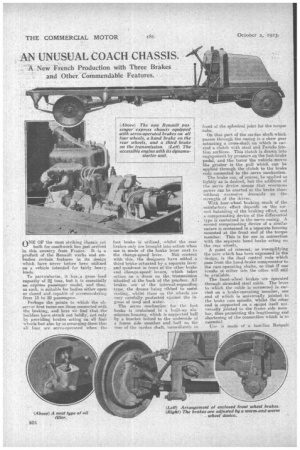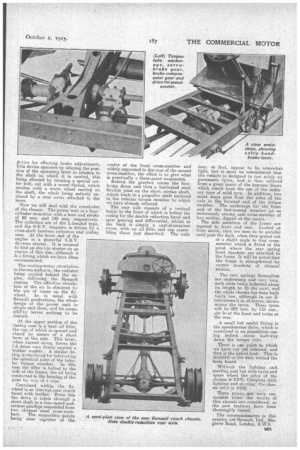AN UNUSUAL COACH CHASSIS.
Page 10

Page 11

If you've noticed an error in this article please click here to report it so we can fix it.
A New French Production with Three Brakes and Other Commendable Features,
ONE OF the most striking Chassis yet built for coachwork has just arthed in this country from France. It is a product of the Renault works and embodies certain features in it design which have never before been utilized on' a vehicle intended for fairly heavy leads.
To particularize, it hsa.s. 1-4ross load -capacity of 2a. tons, lint it is essentially an express passenger model, and thus, as such, is suitable for bodies either .apen or closed and capable of accommodating from 15 to 20 passengers.
Perhaps the points to which the ebserver first turns are those connected with the braking, and here we find that the builders have struck out boldly, not only by providing brakes acting on all four wheels but also by se arranging them that all four are servo-operated when the
foot brake is utilized, whilst the rear brakes only ire brought into action when use is made of the brake lever next to the change-speed lever. Not content with this, the designers have .added third brake actuated by a separate levetand quadrant. in. front of the other brake and change-speed levers, which. takes action on a drum On the transmission Situated at the back of the gearbox. All brakes are of the internal-expanding type,, thedrums-being ribbed to assist cooling, whilst those on the wheels are very carefullyprotectOd against the ingress of mud and water.
The servo mechanism for the foot brake is contained in a built-up aluminium housing, which is supported half by a bracket boiled to the underside of a frame side member and half on the rear of the cardan shaft, immediately in
fiont of the spherical joint for the torlue -tube.
On that part of the cartian shaft which passes through the casing is a skew gear actuating a cross-shaft on which is carried a clutch with steel and Ferodo friction surfaces. This clutch is drawn into engagement by pressure on the foot-brake pedal, and the faster the vehicle moves the greater is the pull which can be applied through the clutch to the brake rods connected to the servo mechanism.
The brake cans a comae, be applied as
lightly as is desired, but te addition of the servo device means that enormous power can be exerted at the brake shoes without excessive demands on the strength of the driver. With four-wheel braking much of the satisfactory effect depends on the cm-red balancing of the braking effort, and compensating device of the differential type is contained in the servo easing. A second oompensating device of a similar nature is contained in a separate housing mounted at the front end of the torque member. This is for use in connection with the separate hand brake acting on the rear wheels.
A point of interest, as exemplifying
the care which has been expressed in the design, is the dual control rods which pass from the heed-brake compensator to the cam-operating shafts, so that if one breaks at either side the other will still be available.
The front-wheel brakes are operated
through stranded steel cable. The lever to which the cable is connected is carried. on a brake:operating member, one end of which is universally jointed to the brake cam spindle, whilst the other end is supported on a spigot itself universally jointed to the frame side rneni bee thus permitting the lengtheitin.gand
i
shortening of the connection which s so essentia•I.
Use is made of a. familiar Renault
device for effecting brake adjustments. This device operates by altering the position of the operating lever in relation to the shaft, on which it is carried, this being effected by rotating a special cotter bolt, cut with a worm thread, which meshes with a worm wheel carried on the shaft, the whole .being entirely enclosed by a neat cover attached to the lever.
Now we will deal with the remainder of the chassis. The power Unit is a fourcylinder monoblee with a bore and stroke of 85 mm. and 140 mm. respectively. The cylinders are of the Lleaded type, and the S.E.V. magneto is driven by a cross-shaft between cylinders and awing case. At the front end of the engine is a powerful S.E.V. dynamo starter. It is unusual to find an electric starter on an eng'ne of this size, although it Is a fitting which we have often recommended. • The cooling-water circulation is thermo-siphocic, the radiator being carried behind the engine, following the Renault custom. The effective circulation of the air is obtained by the use of vanes on the flywheel. As is usual with Renault productions, the whole design of the power unit is simple and clean, and its acces, sibil'ty leaves nothing to be desired.
At the upper portion of the timing case is a neat oil filler, the cap of which is opened and closed by means of a short lever at the side. This lever, when turned down, forces the I'd down very firmly against a leather washer., .A similar fitting is emnloved for hibricatIng the spherical joint of the tubular torque member. In this case the filler is bolted to the side of the frame, the oil being conducted to the housing of the joint by way of a nipe.
Contained within the flywheel is an internal-cone clutch faced with leather. From this the drive is taken through a short shaft to a four-speed-andreverse gearbqx suspended from two channel steel cross-mem bers. The supporting points being close together at the centre of the front cross-member and widely separated the case of the second cross-member, the effect is to give what is practically a three-point suspension. Behind the gearbox comes the footbrake drum and then a laminated steel flexible joint on the short cardan shaft, which leads to a propeller shaft enclosed in the tabular torque member to which we have already referred. The rear axle consists of a vertical banjo to the front of which is bolted the casing for the double reauction bevel and spur gearing and differential, whilst at the back is simply a cast-aluminium cover, with an oil filler and cap resembling those just described. The axle may. at first, appear, to be somewhat light, but it. niu.st be remembered that the vehicle is designed to run solely on pneumatic tyres, and is thus relieved from a great many of the hammer blows which result hum the use of the ordinary type of solid tyre. In addition, two stout stays pass from the' sides of the axle to the forward end of the torque member. The anchorage for the front end of the last-named member as an enormously strong. cast cross-niember of box section, dipped at the centre.
The side members of the frame are tapered to front and rear. Looked at from above, they are seen to be parallel until past the dash, when they spread out at a slight angle to that crossmember which is fitted at the point where the rear spring front brackets are attached to the frame. It will be noted that the frame is strengthened by cornerbrackets of channel section.
The rear springs' themselves are underslung and very long, each plate being indented along its length to fit the next, and .the whole chassis has been built fairly low, although in our illustrations it is, of course, shown minus the tyres. These tyres will be 895 mm. by 135 mm., ,sin:le at the front and twins at the rear.
A small but useful fitting is the speedometer drive, which is contained in an aluminium casing bolted about half-way down the torque tube.
There is one point to which we have rot 'yet referred, and that is the petrol tank. This is situated on'the' dash behind the facia board.
Without the lighting and starting unit but with tyres and spare Wheel the price of the chassis is '2570. Complete with lighting and st-irting, the chas sis priee is 202. • These prices .are very reasonable when the merits of this chassis .are considered, as the new features, have been thoroughly tested.'
The concessionnaires in this country are Renault, Ltd., Seagrave Road, London, S.W.6.
































